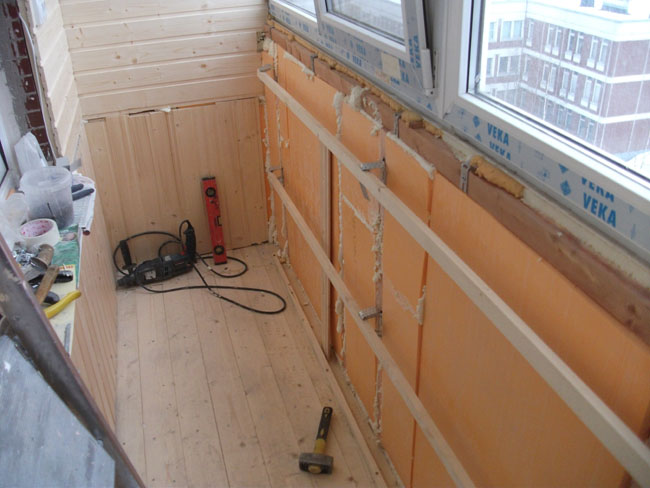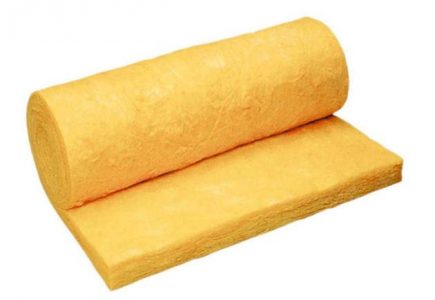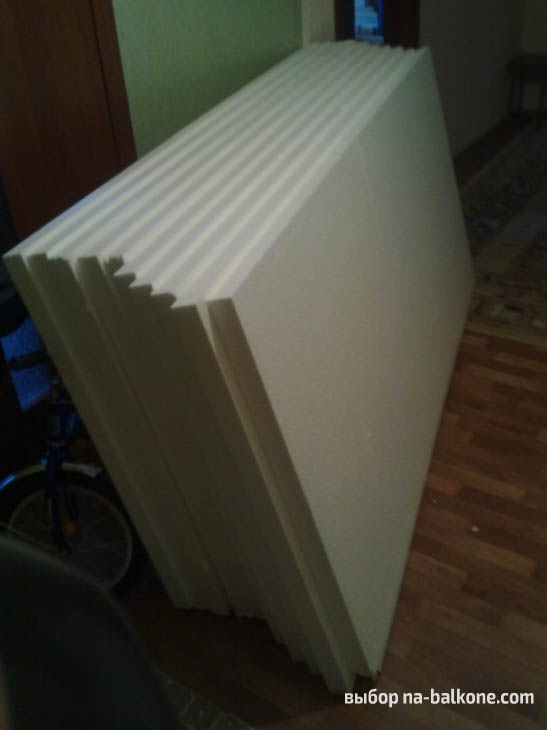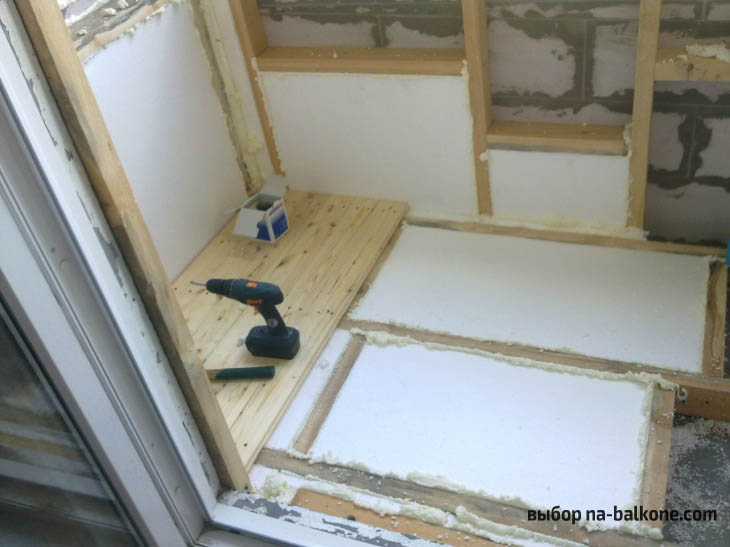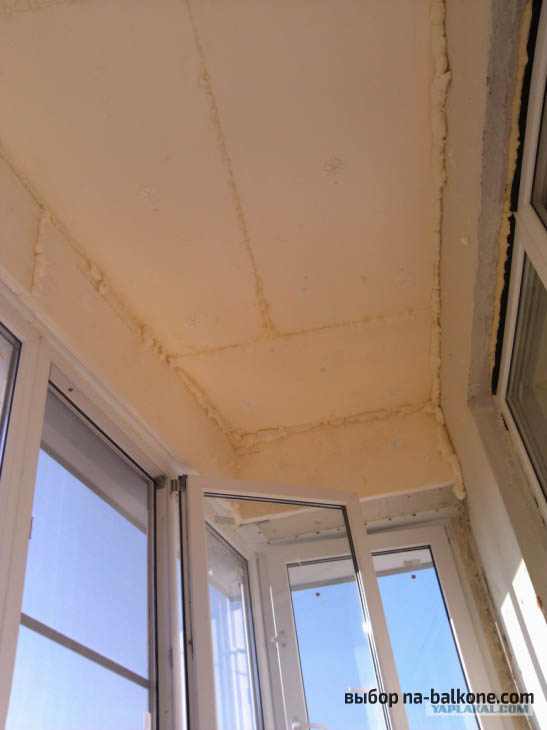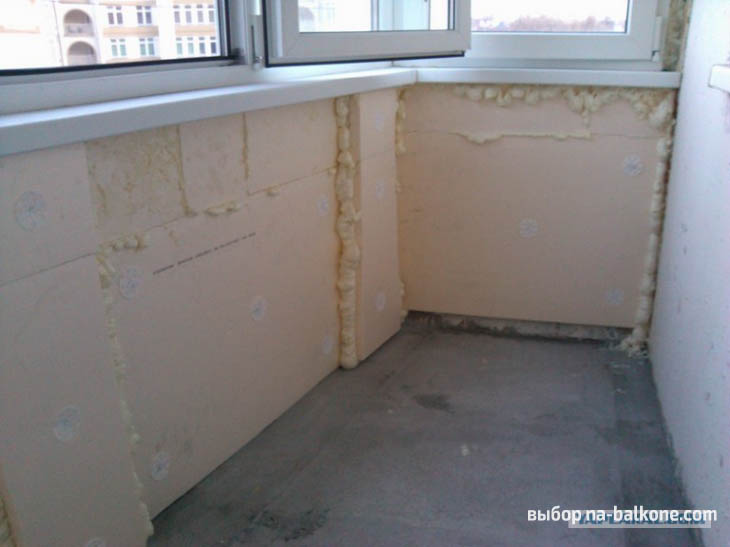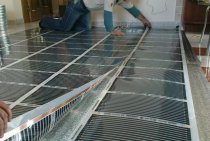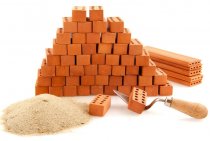How to insulate a balcony what materials are better to choose

To understand how to insulate a loggia or balcony, let's first figure out what properties the materials should have:
- high strength;
- fire safety;
- water resistance;
- environmental friendliness;
- relatively low cost;
- ease of installation (if we want to do all the work with our own hands).
Most often, mineral wool, polystyrene foam, polystyrene, etc. are used for insulation. Sometimes several of these materials are combined. We have reflected the pros and cons of each heat insulator in the table:
| insulation | Advantages | Flaws |
| Expanded clay | Low cost; Durability; fire safety; Not afraid of mold and mildew; Light weight; Easily takes any shape | High moisture permeability; Suitable only for floor insulation; May be difficult to install |
| Mineral wool | Good sound and heat insulation; Environmental friendliness; fire safety; Easily takes any shape | Deterioration of properties when exposed to water; The thickness of the insulation "steals" the usable area |
| Styrofoam | Low cost; Ease of installation; Light weight; Not afraid of mold and mildew | fragility; combustibility |
| Extruded polystyrene boards | High strength; Ease of installation; moisture resistance; Durability | Relatively high cost |
| polyurethane foam (liquid insulation) | High strength; moisture resistance; Durability; Fills cavities of any shape | Relatively high cost; Mandatory availability of special equipment |
| Penofol (foamed polyethylene with a layer of metal foil) | moisture resistance; Durability; Small thickness; Good thermal and waterproofing | Rarely used as an independent heat insulator, usually only in combination with other materials |
What is the best insulation for a balcony? The answer to this question depends on your preferences and financial capabilities. You can read more about the characteristics of heaters, as well as about the insulation of an apartment as a whole, in our blog.
Interior wall decoration
The technology of do-it-yourself balcony wall insulation depends on the design of the parapet and the heat-insulating material used. It is better to sheathe a metal frame, finished on the outside with plastic or corrugated board, with 2 layers of thermal insulation so that the second row of insulation covers all metal racks that are cold bridges. Moreover, from the outside, between the cladding and the insulation, a windproof film should be laid.
When insulating a balcony with mineral wool, it is necessary to use not an ordinary film, but a diffusion membrane as a windscreen. It will let the moisture that occurs in the thickness of the cotton wool out, but will not let it get wet from precipitation or fog on the street. For polystyrene foam and expanded polystyrene, the use of a membrane is not necessary; a regular film is also suitable.
To fix the mineral wool, you will need to assemble with your own hands an additional wooden frame made of bars, whose width is equal to the thickness of the insulation. The step between the bars is selected according to the width of the material, the latter is inserted between them by surprise. At the last stage, the heat-insulating layer is covered with a vapor barrier film, after which the frame is sewn up with clapboard or drywall.
Finishing
After completing the thermal insulation of the loggia, it is worth thinking about finishing work, which also affects the degree of thermal insulation in the room. When all layers are laid and sealed, metal hangers must be returned to their original position, and then aluminum profiles must be attached to them.
It is convenient to attach almost any of the materials available on the modern construction market to these profiles.As a finishing material for the walls of the loggia, wooden, cork and metal slatted panels, PVC structures, siding and many other options are perfect.
Moisture-resistant drywall has proven itself quite well. The advantages of this material lie in the lightness of the structure, which "breathes" perfectly. Drywall is very affordable in terms of price, and it is also easy to process, paint, fix, stick wallpaper on its surface.
At first, warming a loggia may seem like a rather complicated and time-consuming process. However, if you decide to try, you will quickly realize that there are no particular difficulties here. All operations are quickly mastered and do not require special construction skills.
From the balcony it will also be possible to make a comfortable and useful room. For example, equip it with an office, a workshop, a small sports area or a comfortable rest room.
Insulation with mineral wool
Read on the topic - foam insulation. How to fasten, lay and glue.
Before starting work, it is necessary to calculate the amount of material:
- Wooden beam 60 cm. Its quantity depends on how many layers it is planned to make a protective layer.
- For laying a layer 10 cm thick, it is recommended to use 5 cm thick cotton slabs and form a second layer from them, where the blocks are located perpendicular to the direction of laying the first layer.
- Glue for gluing protective blocks and a vapor barrier film are purchased based on the total area of the insulated surface.
Preparing for the installation of mineral wool slabs
The floor, side walls, ceiling and parapet (if any) are covered with mineral wool slabs. Blocks of insulating material are laid inside the wooden crate. Its installation has the following features:
- The thickness of the wooden beam is 50-60 mm.
- The vertical or horizontal arrangement of the beam is determined by the design and shape of the decorative trim panels and the way they are installed.
- Wooden elements are fastened with self-tapping screws and dowels to concrete or a brick wall.
- The gaps between the frame elements for mineral wool blocks should be 1-2 cm smaller than the size of these blocks for a tighter fit.
- With a two-layer method of laying thermal insulation, the frame bars of the second layer are laid perpendicular to the crate of the first layer.
Glue for mineral wool
The use of a special cement-based adhesive allows you to completely block the movement of air between the insulated surface and the insulation. Full gluing of a two-layer protection, when the blocks are laid perpendicular to each other, allows you to create a dense monolithic barrier without accidental cold bridges. Fungi - dowel nails with wide washers can serve as additional fasteners for blocks.
vapor barrier
A roll of vapor barrier material is spun along the surface to be insulated over the stone wool layer. The material is fastened with a furniture stapler to the wooden elements of the frame. The butt overlap should be at least 10 cm. The joints are additionally sealed with double-sided tape. The places where the vapor barrier film adjoins the ceiling, walls, floor and window profile are closed with a waterproof sealing tape.
Installing the counter beam
The counter beam is used to fix the decorative trim panels. Before installation, double-sided tape is applied to its surface, which should be adjacent to the vapor barrier coating. Fixation is carried out using self-tapping screws to the elements of the crate located behind the vapor barrier layer.
Heater on the floor
To install the frame under the floor insulation, a wider beam of 50X100 mm is used. The step between the lags is recommended to be the same as that used when installing the wall and ceiling sheathing. Under plates 60 cm wide, it is necessary to make a step of 58-59 cm for a tighter fit.Floor covering can also be done in 2 layers. For installation of 100 mm mineralized wool insulation. it is allowed to arrange 2 layers of 50 mm each with mutually perpendicular arrangement of blocks. Before installing plywood or fiberboard, a vapor barrier film is applied to the thermal insulation layer and attached with staplers. All joints of the vapor barrier material are overlapped with double-sided adhesive tape.
Floor finishing
Plywood sheets or boards are laid on the logs of the frame, covered with a vapor barrier film, and fastened with self-tapping screws. The flooring is recommended to be made two-layer, when the elements of the second layer are laid across the elements of the first. Only after that, the linoleum, laminate or parquet laid on top will last a long time.
Internal wall, ceiling and parapet cladding
The choice of decorative panels for finishing the insulated balcony is very wide:
- Drywall.
- Siding.
- Clapboard.
- Decorative plastic panels.
If the insulation and vapor barrier layer have been installed correctly, then no facing coating will suffer from temperature changes, moisture penetration, or ice. The interior of the insulated balcony becomes fully habitable, and it can be used as such all year round, which increases the total living space of the apartment.
Insulated glazing interior
Metal clamps on an aluminum profile that cover a layer of vilaform or other insulation are lined with plastic decorative panels with the desired shades, or for painting. Multilayer double-glazed windows become full-fledged apartment windows, so the balcony doors can not be closed.
Carrying out work on the loggia or balcony using mineral wool
But before you are going to insulate the balcony directly with the wool itself, you need to carry out additional work. Thermal insulation itself, no matter how good it is, will not give anything if you have old window frames on the loggia or there are gaps somewhere.
If you have a loggia, then the preparatory work will be much less than on the balcony. Firstly, loggias most often have side walls and, in addition, the front wall is made of blocks or bricks, which cannot be said about the balcony.
Stages of preparation for installation:
- the first stage is to restore order, that is, it is necessary to completely free the loggia from all items, including building materials;
- taking measurements and calculating the materials necessary for the work - this stage is important because it will help you avoid unnecessary costs, at current prices for building materials this moment plays a big role;
- it is also necessary to assess the condition of the slab - whether it can withstand additional load, if you are not able to do it yourself, then you need to invite a specialist.
After carrying out the preparatory work and purchasing all the materials, you can proceed directly to work. First of all, double-glazed windows are installed, what they will be, wooden or metal-plastic, you decide.
Next, you need to prepare the surface itself for mounting the insulation, in our version of mineral wool. If there are gaps and holes, then they must be eliminated, sealed with mounting foam and plastered. After that, we proceed to the waterproofing of surfaces, this process is not as complicated as it seems. There are two main methods of waterproofing, it is coated or rolled. In a city apartment, the second option is more preferable, since bitumen is most often used as a coating, but its smell can persist for a long time. The implementation of this stage of work is mandatory, since without the necessary waterproofing, mineral wool may soon become unusable.
How to insulate the balcony inside
A positive result of the work performed is the equally comfortable temperature inside the room and the balcony adjacent to it.It makes no sense to invest effort and money in insulation that does not protect against the penetration of cold onto the balcony and forces you to tightly close the doors leading to the loggia in winter.
Here, the type of insulation used and its thickness, as well as compliance with the technology of work, play an important role.
As a rule, for internal insulation of balconies is used:
- foamed polystyrene with a density of 25-35 kg / m 3, otherwise - polystyrene;
- mineral wool based on basalt fiber 80-110 kg / m 3 density;
- extruded polystyrene foam (one of its varieties is penoplex).
Note! For additional thermal insulation, thin foil insulation made of polyethylene foam - Isolon or Penofol is often laid on the main layer.
In addition to the above insulators, there is another insulating material - ecowool, made from cellulose waste. In other words, waste paper. The rules for handling it and the installation technology are used the same as with basalt wool. Ecowool is not very popular due to its high cost.
Insulation of the loggia from the inside with clapboard
Another do-it-yourself method: using lining. Lining burns 3 times weaker than polystyrene, and is almost non-hygroscopic, unlike mineral wool. In addition, lining is an environmentally friendly material.
Tools and materials:
- wooden logs;
- lining strips;
- perforator;
- dowel-nails;
- wood screws;
- cordless screwdriver;
- nails without hats;
- thin nails;
- hammer.
To insulate the loggia with a clapboard, logs are nailed to the walls under the level, it is on them that the clapboard is attached.
To insulate the loggia with a clapboard with your own hands, you first need to prime the surface of the walls, floor and ceiling. After that, using a puncher and dowel-nails, nail wooden logs to the wall, floor and ceiling. On them, starting from the corner of the wall, we nail the lining strips with a hammer and nails, and we drive the nails at an angle. At the end of the lining strip, you need to fasten it with self-tapping screws, drowning them inside the lining with a cordless screwdriver at slow speeds. Thus, we fix each strip of lining from 2 ends.
From above, we cover all the corners of the loggia with a plank, nailing it with a hammer and thin nails.
The lining itself is a decorative material, so no finish needs to be fixed on top of it, unless, if desired, it can be coated with a double layer of varnish.
The lining is heavy and expensive. It can only sheathe a loggia (but not a balcony) adjacent to a heated room, since the lining has little heat-insulating properties.
Foamed polyethylene has good heat and waterproofing properties, is quite cheap, durable, easy to use (does not scatter throughout the room, like mineral wool), thin and light (unlike lining), does not burn (like foam), melts when burned, releasing toxic substances.
Tools and materials:
- rolls of penofol with an additional layer of foil (for better vapor barrier);
- glue for penofol;
- glue brush;
- roller;
- scissors.
http:
https://youtube.com/watch?v=EmsXWnchQXE
To insulate the loggia with your own hands with foamed polyethylene, we apply glue to the primed surface of the walls, ceiling and floors of the loggia. We cut out the pieces of penofol necessary in size, apply a layer of glue and glue it so that the foil layer is outside. Level with a roller.
We process all corners, joints and the parapet of the loggia with mounting foam.
We mask the penofol from above with laminate, drywall or wall panels. Since the aluminum that is part of the foil of the foam rolls is a good electrical conductor, it is necessary, in order to avoid a fire hazard, to isolate the electrical wiring on the loggia well.
Cons and pros of mineral wool
If, when choosing a heater, you still settled on mineral wool, then it would be nice for you to know about the advantages and disadvantages of this material.Where and how it can be used, what properties it has and whether it is safe for humans.
Benefits of mineral wool:
- if you live in a city and your side is a noisy courtyard or a busy highway, then you can immediately appreciate the soundproof properties of mineral wool;
- in cold weather, you will understand to what extent it protects against frost and allows you to keep warm in the room, and therefore save on heating;
- its small weight is also its advantage;
- due to its physical properties, mineral wool is convenient for installation, because it can be given any shape;
- and another great advantage of it is that it does not burn, that is, it is safe.
People love comfort and safety, and warming the balcony with mineral wool provides this.
Cons of mineral wool:
- its biggest disadvantage is that it can intensively absorb moisture, as a result of which, over time, lose its properties and deform;
- the second drawback is that during work with it dust harmful and dangerous to humans is formed, so it is necessary to use a respirator.
These shortcomings of this material are of course significant, but they can be circumvented by applying some actions. For example, when you are insulating a loggia with mineral wool, you can use special waterproofing materials to protect it from external influences. During work with mineral wool, you can protect your body with an ordinary respirator and overalls. The safety rules are the simplest, but they will help to avoid major troubles. In addition, upon completion of work directly with mineral wool, it is best to immediately clean up the place of work so that small pieces of cotton wool and its dust do not spread throughout the apartment.
Floor device, determination of the amount of materials
In order to quickly and successfully cope with the task, you need to have a clear plan. In this case, this is the plan of the loggia. We measure the length and width of the loggia, as well as niches and ledges, if any.
The scheme of the layout of the bars
On the plan of the loggia, we determine the layout of the transverse and longitudinal bars. In doing so, we adhere to the following rules:
- the bottom row consists of transverse bars, which are laid out along the loggia, the step between the bars is 40-60 cm;
- the upper row consists of longitudinal bars located along the loggia, the distance between the longitudinal lags should be no more than 45 cm.
In standard loggias, it is enough to lay three longitudinal beams. If the loggia has a width of 1.2 m, then you can lay the extreme bars at a small distance from the walls: 10 cm from the inner wall and 20 cm from the loggia fence. The length of the longitudinal beam can be shorter than the length of the loggia by 10-15 cm (5-7 cm on each side).
Floor construction height
It is important to correctly determine the height of the floor. For good insulation, it is enough to make the floor 10-20 cm thick
It is necessary to check how the floor will approach the threshold of the balcony door and match it in height. In this case, it is necessary to take into account all the elements that make up the structure: the height of the transverse and longitudinal beams, the thickness of the subfloor (chipboard) and the thickness of the finishing coating.
In order to achieve the desired floor height, you can choose a timber that is suitable for height and chipboard thickness. It must be remembered that the thinner the thickness of the chipboard, the smaller the distance between the longitudinal bars should be. The recommended chipboard thickness is 18 mm, the recommended height of the upper (longitudinal) row of beams is 70 mm. The height of the bars of the first row is 50-70 mm. For an accurate calculation of the required amount of floor materials, you can use our calculator.
After drawing up the layout of the bars, the required amount of material for the floor frame is determined. The number of chipboard is determined based on the floor area and the width of the loggia. Having decided on the size of chipboard sheets, you can immediately order their cutting in the store.
For flooring you will need:
- timber 50x70 (or 60x40, 50x50) mm, depending on the height of the structure;
- sheet chipboard 18-20mm thick;
- mineral wool;
- frame anchor 112 mm long;
- self-tapping screws 70 mm and 40 mm long;
- mounting wedges;
- drill;
- screwdriver;
- level;
- construction knife;
- mounting foam;
- protective glasses;
- gloves.
Floor insulation
The technology of thermal insulation of balcony floors differs from walls and ceilings, since the “pie” of insulation must bear certain dynamic loads and have a flat surface. Alignment is carried out by laying wooden logs, between which a heater is laid, and a finishing coating is laid on top. The sequence of actions is as follows:
- Cut a wooden beam into crossbars along the width of the balcony and fix them to the floor with anchors or self-tapping screws and dowels using steel corners.
- Fasten 3 longitudinal logs to the crossbars on self-tapping screws. In the process, they must be aligned horizontally, starting from the highest point. Using the building level, the beams at the intersection with the crossbars should be raised and plastic or wooden wedges should be placed.
- Between the crossbars and the log, lay the insulation tightly. In the case of mineral wool, a vapor barrier must be laid on top of it.
- Lay a floor covering with fastening to the logs.
Note! Some craftsmen practice insulation of the balcony floor with polystyrene foam without installing a log. The method is unsuccessful, since it will be difficult to bring the surface of the floors to one level. See floor leveling instructions here.
It is characteristic that the length of the crossbars and the log does not need to be adjusted to the dimensions of the balcony. It would be more correct to make them shorter by 10-20 mm so that the ends do not rest against the walls. Wood has the ability to "breathe" and deform a little; with a tight fit, the floor surface may later arch.
Moreover, walking on such floors will be accompanied by an annoying creak. The resulting gaps near the walls will hide under the floor covering and become invisible.
When using slab heaters, it is worth choosing the step of the crossbars correctly so that you do not have to cut the slabs once again. The standard width is 600 mm, and you need to focus on it. After laying foam or expanded polystyrene, all joints and cracks must be filled with mounting foam.
Useful instructional video:
https://youtube.com/watch?v=GPDTFtvh-Go
Mineral wool is protected with a vapor barrier as tightly as possible so that moisture from inside the room cannot seep into it.
Here, too, you can use foamed polyethylene such as Penofol, but pay special attention to gluing the joints
If you seriously and scrupulously approach the procedure for internal insulation of a balcony, then it is not at all necessary to hire craftsmen and pay them money, which is never superfluous. You will spend twice as much time to complete the work, but you will do everything with high quality and in accordance with personal wishes. In addition, save money for the family budget.
Balcony preparation
The first stage is the preparation of the premises for work.
- Cleaning the surface from cement, paint and other irregularities. The working wall or floor must be smooth, otherwise the insulation will be difficult to lay.
- Cleaning dust and debris from the floor. All dirt must be carefully removed with a vacuum cleaner so that it does not get into the cracks.
- Sealing of internal openings, joints, cracks. Large cracks are filled with sealant or cement mortar. The gaps between the plates are cleaned with foam.
- Removal of excess hardened foam, sealant. Coating the surface with a primer.
Next, you can proceed to the waterproofing of surfaces. A properly laid protective layer will protect the house from mold.
The choice of heat insulator
Advantages and disadvantages are inherent in each type of thermal insulation. In order to choose the most suitable insulation, you should compare the main characteristics of heat insulators.
The most common options for heat insulators:
- Extruded polystyrene foam (penoplex);
- Foamed polyethylene (penofol);
- Polyurethane foam (PPU);
- Styrofoam;
- Mineral wool.
Mineral wool
The thickness of the sheets varies from 2 to 20 cm. Mineral wool is divided into three types, depending on the components of the raw materials:
An example of a mineral wool device on a loggia. The material is placed in the prepared structure. The frame for mounting can be made of metal profiles or wooden bars.
Manufacturers produce cotton wool in the form of mats and soft rolls. In some cases, one side is covered with foil. Aluminum foil improves the level of thermal insulation.
The main disadvantage is that moisture acts destructively, a vapor barrier device is necessary.
Polymer-based insulation
Penoplex, polyurethane foam, polystyrene, foamed polyethylene are polymers treated with foamed compounds.
Advantages:
- The presence of gas bubbles provides not only a good level of thermal insulation, but also a small weight of the plates;
- High degree of moisture resistance;
- The materials are durable;
- Antifungal resistance;
- Simplicity and convenience when laying plates or sheets, as well as rolls (polyethylene foam);
- An economical repair option, subject to the choice of foam as a heater.
The main disadvantage: they support the spread of flame during a fire, emit harmful substances during combustion.
When choosing foam and other materials based on polymers, it is necessary to correctly select the thickness of the plates and determine the density
1. Styrofoam sheets
Insulator plates (expanded polystyrene) in the process of laying.
Styrofoam refers to budgetary methods of warming a loggia, however, it is considered a rather fragile material, therefore, a crate is necessary for installation. A worthy replacement is extruded polystyrene foam; its installation does not require the creation of a special frame.
2. Penoplex
Extruded polystyrene foam boards (thickness 50 mm) are used as insulation. The seams between the elements are sealed with mounting foam. Penoplex is attached with the help of special dish-shaped dowels ("fungi").
3. Penofol
The material is used as a separate heat insulator, and with the help of penofol it is possible to provide a vapor barrier of expanded polystyrene. Due to the foil side, warm air is reflected and retained in the room.
In order to speed up the insulation of the structure, you can use an alternative method of thermal insulation - spraying polyurethane foam (PPU).
4. Polyurethane foam
PPU is one of the most modern heat insulators. The cost of application services is considered high compared to other analogues, but many have managed to evaluate the performance properties of polyurethane foam. This insulation is characterized by high thermal insulation performance, due to the finely porous structure.


